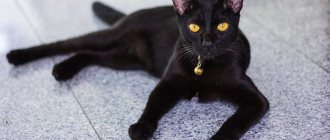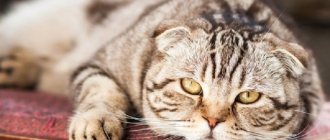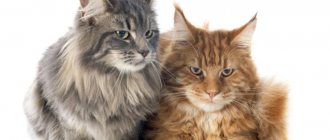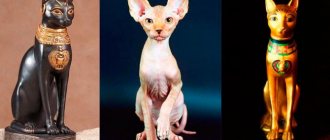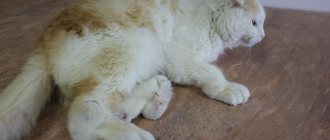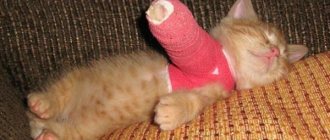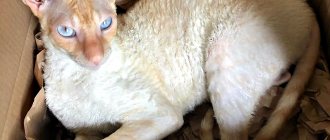Video
* We invite you to watch a video about the Cornish Rex . In fact, in front of you is a playlist in which you can select and watch any of 20 videos about a given cat breed by simply clicking on the button in the upper right corner of the window. In addition, the material contains quite a lot of photos. By looking at them you can find out what a Cornish Rex looks like.
In this article:
|
Rate the material!
[Total votes: 1 Average: 5]
Cornish Rex cat breed was born not so long ago - only in the middle of the last century. Its representatives differ from other cats in their absolutely fantastic appearance, as well as short curly hair. In addition to the unusual coat, the image of graceful creatures is favorably complemented by expressive, intelligent eyes and rather large ears. These cats have a wonderful character, are gentle and playful, so fitting into any family is not a problem for them.
Education and training
Two-faced Cornish Rex
In the cat world, Cornish Rexes are known as true intellectuals, so they are easy to train, even as playful kittens.
As soon as your baby steps foot into your home, draw a clear line between what can and cannot be done, and adhere to this requirement throughout the pet’s life. At the same time, it is categorically not recommended to strictly punish the Cornish for the slightest offense and raise your voice at him. To demonstrate dissatisfaction, it is enough to slap a newspaper on the floor not far from the animal, but under no circumstances raise your hand to it. Otherwise, in the eyes of the Cornish, you will look like a threat, and not a source of love and affection.
Armed with patience, you can easily teach a representative of this breed the basic “dog” commands: sit, lie down, meow and even give a paw. Rexes often learn to bring a ball or other toy to their owner. These cats are calm about walking on a harness and, in general, their behavior is more reminiscent of dogs.
Cornish Rex understand perfectly the purpose of the tray and scratching post, so there will be no problems with maintaining the pet’s hygiene.
History of the origin of the Cornish Rex
The history of the Cornish Rex breed began in 1950 in Great Britain. Farmer Nina Ennismore suddenly discovered that among the kittens of a recently lambed cat, there was one with a very unusual appearance. What was unusual about the kitten was its curly fur and simply huge ears, which gave it an alien appearance. Ordinary kittens were soon distributed to neighbors, and the unusual kitten was left in the owner’s house and given the same unusual name - Kalinbuker.
Six months later, the farmer decided to castrate Kalinbooker, but the veterinarian, seeing how the cat looked, persuaded her not to do it. He suggested that the unusual pet could mark the beginning of a completely new breed. Nina Ennismore listened to the veterinarian and as a result of mating the cat Kalinbooker and the cat Serena (his mother), three more kittens were born, two of which looked like their father. Only one of them, who was named Poldu, survived to adulthood.
The English farmer's crossbreeding experiments continued for several more years and approximately half of the offspring from each litter were born with curly hair and large ears. A few years later, the farmer was overtaken by serious financial problems, because of which she stopped breeding curly-haired cats and euthanized her pets: the cat Serena and the cat Kalinbooker. The cat Pold managed to avoid a sad fate - he was bought, but then by mistake he was castrated. Fortunately, Poldu has several curly-haired descendants.
Interesting fact: One famous American cat lover, Frances Blanchery, managed to buy two Cornish Rex cats in England in 1957 - descendants of Pold. It was a red cat and a pregnant blue and white female. The woman took them to America, to her homeland. Soon the cat calved and there were two curly-haired kittens in the litter, from which the branches of the breed in the USA later originated.
For about 30 years, American breeders crossed Cornish Rex cats with Burmese, Siamese and other shorthair cats. Thanks to this, the breed not only acquired new colors, but also became very popular among cat lovers. The Cornish Rex breed was officially registered in 1983. It also officially recognized two lines - British and American.
Origin, description, appearance
The history of the breed began in the mid-20th century in the southwest of Great Britain. Farmer Nina Anismore gave birth to a baby with curly hair in her litter of short-haired cats.
The woman was interested in the unusual type of animal, and she decided to start breeding a new breed. Siamese and British cats took part in the selection, but the recessive trait was not immediately established.
Cornish Rex
In 1958, American breeders liked the unusual kittens, and they took two curly-haired kittens overseas. Thus began the history of the American Cornish Rex subspecies.
The European branch of the breed achieved recognition by felinologists in 1967. Curly-haired cats were allowed into exhibitions almost 30 years later.
Curly hair in cats as a result of a gene mutation was first recorded in 1937 in Moravia. The unusual appearance was considered a serious defect caused by disease.
Cornish Rexes are graceful, agile animals. Despite their apparent fragility, cats are athletically built. The body is elongated, the back is slightly arched.
The standard regulates the following exterior features:
- The head is egg-shaped with high cheekbones.
- Nose with a pronounced hump.
- The mustache is long and wavy.
- The ears are large and set high.
- Eyes of green, amber-green colors. A blue tint is also allowed. It is important that the color is in harmony with the color of the iris.
- The tail is proportional to the body, similar to a whip.
- The paws are long.
According to the characteristics, on average males weigh about 5 kilograms, females - about 3 kilograms. The European subspecies is more muscular than the American one.
Coat and colors
A distinctive feature of the Cornish is its curly coat. It is short, without guard hairs, soft, and shimmers like mother-of-pearl in good lighting.
The coat of the Cornish Rex does not cause allergies. Animals do not shed.
The breed standard does not strictly regulate the color of the Cornish Rex.
The most common are the following:
- Charcoal black with no hints of anthracite or smoky grey. The eyes of cats of this color are most often golden.
- Red. It has many shade options from copper red to sunny red. The eyes are golden.
- White. These cats have golden or blue eyes.
- Rich gray-blue - a legacy of crossing with Siamese cats. The color should be uniform without inclusions of extraneous shades.
- Calio. The most unusual Cornish. They are white with spots of red brick or pastel colors. Eyes – green, blue or multi-colored.
Be sure to read:
Toyger cat - a breed similar to toy tigers, description and character of a tiger cat
Allowed shades of wool are silver, smoky gray or blue, brindle, tortoiseshell, cream bicolors.
Cornish Rex - description of the breed
Cornish Rex cats are usually not very large. An adult cat usually weighs 4–5 kg, and females even less. The animals look quite sophisticated and even elegant, but all their muscles are well developed. It is worth noting that the bone structure of the British line of the breed is somewhat heavier than that of the Americans.
According to the American standard, Cornish Rex cats look like this:
- Narrow and somewhat elongated body;
- Very developed muscle corset;
- Egg-shaped head;
- Wedge-shaped muzzle;
- Roman nose;
- High cheekbones;
- Strong jaws;
- Large cone-shaped ears;
- Large oval, slightly slanted eyes;
- Slightly arched back;
- Wide chest;
- Tight stomach;
- Thin, slender and long limbs (the front legs are shorter than the hind legs);
- Long and mobile whip-like tail;
- Soft curly coat without guard hairs and available in a wide variety of colors.
It is important to understand that the Cornish Rex breed has some similarities with the Devon Rex breed and it can be quite difficult for an inexperienced person to distinguish between these two cats. The difference here primarily lies in the shape of the head. For example, in the former it is ovoid, in the latter it is heart-shaped. Also, in Cornish Rexes the nose blends more smoothly into the forehead.
There are also some differences in body structure. So, Devons have a shorter body and stronger bones. Another difference can be found if you carefully examine the fur of both cats. For example, in Cornish cats most of the hairs are curved downwards, while in Devon Rex hairs look tousled and directed upwards.
Description
Cornishes are small, medium-sized cats whose fur is wavy and soft. Slender, long-legged and graceful animals. Sexual differences are pronounced: males are larger.
Head and muzzle
Wedge-shaped skull with a low forehead and prominent cheekbones. A well-defined chin, forming a well-defined line with a long nose. High and large ears, rounded at the top. Almond-shaped, slightly slanted eyes.
Body, paws, tail
Cornish cats are not characterized by large sizes. The body is gracefully elongated. Strong, muscular thighs smoothly transition into elongated, slender legs with oval hands. The spine has a curve. Thin, long tail.
Wool
The formation of wool is completed by the year, it covers the body in uniform waves. The guard hair is reduced, which is a characteristic feature of the rex.
Inexperienced breeders believe that the skin is hypoallergenic, however, this is a misconception.
Colors and types
The most classic and recognized types are:
- White. Clean, without stains or inclusions, pale pink paws. Blue or amber eyes.
- Black. Rich tar, yellow eyes.
- Blue. Light even color. Blue nose and paw pads, golden eyes.
- Red. Solid brick-red tone of fur, nose, paws.
- Chocolate. Rich soft brown shade for the body, cinnamon for the paws. Amber eyes.
- Lavender. Warm with a pink tint, cream spots are allowed, the nose and pads are lilac or pinkish.
- Tortoiseshell. Very bright, consists of a combination of any three colors: red, black, gray and others. Paws of the tone that dominates. Eyes are golden or green.
- Calico. Tricolor with white dominance. Eyes – blue, yellow.
- Tabby. Various colors, the main difference is the striped pattern covering the entire body.
- Bicolor. Two-tone, combines black with white, tabby with lavender and so on.
Character
Cats retain childlike activity until old age, they are active and cheerful. They are very inquisitive and intelligent, often showing stubbornness. It would not be an exaggeration to say that these cats are true intellectuals, sensitive to the mood of their household members.
Rex, like real kings, cannot tolerate neglect, seeking attention by any means. They quickly become attached to their owner and love him very much, but they are selfish and guided only by their own desires.
It is difficult to say how this or that Cornish will behave towards an opponent, since rexes are very jealous. Breeders often say that they are not sociable with other pets.
Children love them very much, to which cats reciprocate completely and are extremely gentle with the child. Rexes are not annoying, but they need warmth and affection; they love to sit in the arms or next to the owner and purr.
Noble animals are easy to train, for example, they quickly get used to walking on a leash and are happy to bring a ball to their owner. These cats do not have the habit of stealing table food or marking furniture.
Popular Cornish Rex colors
Cornish Rex cats have a rather unusual short, wavy and silky coat, similar to the fur coat of a young lamb. Thanks to crossing with other breeds, these cats have a great variety of colors.
Here are some of them:
- White color (pink nose and paw pads, golden or blue eyes);
- Black color (nose and paw pads are brown or black, golden eyes);
- Blue color (blue nose, golden eyes);
- Red and cream colors (nose and paw pads are light brown);
- Smoky-silver color (with dark areas like the colors of Siamese cats, eyes bluish or green);
- Black smoky color (similar to Burmese colors, nose and paw pads are black, green eyes);
- Bluish-smoky color (mask on the face and paws are blue, paw pads are pink);
- Tabby color is classic (paws are colored with dark rings, dark streaks on the sides, dark back);
- Tabby brindle (almost similar to the classic tabby color, but the letter “M” is drawn on the cat’s forehead with dark stripes);
- Tabby spotted (with spots of beige and reddish color);
- Brown spotted tabby (basic coat pattern is classic or brindle tabby on a brown background with spots of reddish and beige);
- Bluish-spotted tabby (brindle pattern on a beige background with a bluish tint);
- Blue spotted tabby (beige color with a blue tint with a dark blue tabby brindle pattern, bright golden eyes);
- Silver spotted tabby (brindle pattern on a silver background with spots, deep golden eyes);
- Silver tabby (classic or brindle pattern, brick-colored nose, bright green eyes);
- Red Tabby (brindle pattern on a reddish background, nose and paw pads terracotta color);
- Brown tabby (dark brindle stripes on a terracotta background, brick-colored nose, golden eyes);
- Blue or cream tabby (classic or brindle markings on a bluish or cream background);
- Tortoiseshell (reddish spots on a black background, dark nose, golden eyes);
- Calico (white background with dull reddish and black spots, blue, golden or bicolor eyes);
- Calico lightened (white background with beige and blue spots, golden eyes);
- Bluish-cream (blue background with rare small beige spots, golden eyes).
As for the popularity of one color or another, the fashion for them changes depending on the year. However, the so-called “pure” colors, without spots, are still more popular.
Funny kittens
Little kittens always bring a smile and affection. Such Cornish Rex kittens can be purchased in nurseries, where breeders are responsible for the health and purity of the breed. And who is closer to your liking - decide for yourself:
- White curly fur, pink nose and the same pads on the paws, blue or golden eyes.
- Blue kitten - the farther from the nose, the bluer. Only the eyes are golden and the nose is gray. And no options.
- It doesn’t get any blacker—the nose, tail, paw pads—blacker than the blackest night. And – golden eyes.
- The nose is creamy - no, rather pink, the paws are soft pink, and the fur has a pinkish tint.
- Red - bright, thick and shiny - golden fleece - fiery sparks in the eyes, on the pads of the paws, on the nose.
Ideal character, ideal pedigree - a miracle cat with strange eyes. It’s impossible not to fall in love!
Character and habits of the Cornish Rex
Cornish Rex cats are very energetic, active and playful by nature. Even at a very old age, they love life and never stop looking for adventure. They like to explore the surrounding space, so it is not advisable to leave Cornish cats indoors for a long time. After all, not knowing where to put the excess energy, they will begin to climb curtains and walls, knock over pots of plants, scratch walls and furniture.
These cats are also very sociable and simply love to be the center of attention. For example, they often like to climb onto their owners’ laps, rub their muzzles against their arms, legs, face and purr, quite loudly, as if they are telling something.
Interesting fact: These animals are very friendly: living in the same house with dogs or other cats is not a problem for them at all, but on one condition - only they should get the lion's share of attention. If this is not the case, then the owners will be defiantly ignored for several days.
Cornish Rex are very partial to children and simply love to play with them. Parents of children should know that such a friendly pet will never allow itself to offend the baby, even if he does something wrong, for example, pulling the tail, touching the hind legs and belly. If unwanted actions on the part of the child are repeated, the Cornish Rex will not bite or scratch, but will simply avoid him, considering him a source of threat.
At first, Cornish Rex cats show distrust of strangers and allow themselves to be petted only when they feel completely safe. It is important to take into account one more point: these cats have a very developed hunting instinct, so it is not recommended to keep birds or rodents in the house where they live.
Care and maintenance
Cornish Rex cats are easy to keep and suitable for people suffering from allergies to wool. Their fur is hypoallergenic, so only the animal’s saliva can cause an allergic reaction.
Shedding of animals is minimal and does not require major adjustments in daily care. Combing is carried out with a special mitten or suede cloth soaked in water. Using rougher tools can damage the hairs. The absence of guard hair interferes with the absorption of sweat, so the animal must be bathed every week. Washing is carried out with veterinary shampoos. After bathing, the pet must be wrapped in a towel and tried to dry, excluding exposure to drafts.
Clean ears weekly that accumulate environmental dust. To cleanse your eyes, use special solutions or chamomile infusion.
Due to the specific structure of their paws, Cornish cats do not know how to retract their claws and can scratch their owner during play. To grind down the claws, train your pet to use a scratching post or trim them yourself with a nail clipper.
Every month, clean your cat's mouth with veterinary paste, moving from the base to the tip of the tooth.
Caring for and maintaining a Cornish Rex is not difficult and will not puzzle even an inexperienced owner.
Interesting facts about Cornish Rex
The main character traits of the Cornish Rex are very similar to dogs. They are also friendly, curious, and have a strong attachment to their owner, following on his heels.
Cornish Rexes are distinguished by intelligence, intelligence and high intelligence. They are much easier to train and train than other breeds. Therefore, with regular training with your pet, you can quickly teach him to fetch thrown objects, as well as to carry out dog commands: “lie down”, “sit”, “come to me”, “no”.
The curly coat of these cats, due to the lack of guard hairs, does not retain heat well, so it is advisable to buy warm houses for them along with beds. Also, due to their activity, a gaming complex would not be amiss.
Cornish wool is not an allergen. Cornish Rex cats have an acute sensitivity to anesthetics. Because of this, they tolerate anesthesia much harder than cats of other breeds and can have the most unexpected reactions to quite ordinary drugs.
The skin of these cats is also very sensitive to ultraviolet radiation. For this reason, it is better to plan their walking time in the morning or evening.
It is better to underfeed these cats slightly rather than overfeed them. After all, with regular overfeeding, they quickly turn into curly sausages. For this reason, it is recommended that they arrange something like fasting days once or twice a month.
To produce healthy offspring, a Cornish Rex cat should not give birth more than once a year. For the same reason, it is not recommended to take too long pauses between births (more than two to three years). After all, the female’s reproductive function can both become exhausted (in the first case) and fall asleep (in the second case).
Cornish Rexes are the longest-living cats. With an average life expectancy of 15 years, many individuals easily live up to 20 years!
Is it true that there are no allergies to Cornish Rex dogs?
It is believed that 15% of all humanity suffers from cat allergies to one degree or another. For allergy sufferers who dream of a pet, the Cornish Rex seems to be a good solution, because this breed is positioned as hypoallergenic.
Pull-ups
This is not entirely true; Cornish dogs can also cause an allergic reaction. It is caused by certain protein molecules found in cats' saliva and on the surface of their skin. This allergen is called Felis domesticus allergen 1. The protein is evenly distributed over the surface of the cat's fur when it is licked.
Particles of cat saliva, dander and hairs disperse into the air, causing allergies in humans. The reaction can also be to cat urine. It has been noticed that males secrete much more allergenic proteins than cats.
It is now clear that it is not the cat’s fur itself that causes allergies. But the risk of allergies when contacting fluffy, long-haired cats is still higher, because these animals shed intensively, scattering salivated fur throughout the apartment.
In terms of hypoallergenicity, Cornish Rexes are significantly ahead of hairless cats - Sphynxes. In Sphynxes, skin secretions (special grease, brownish grease) are a strong allergen.
The decision to adopt a kitten must be deliberate
If you are allergic to cats, it makes sense to check your reaction to the Cornish by arranging a visit with the club’s breeder or friends who have a cat of this breed. Pet the Cornish Rex, hold it in your arms, play with it. Let at least a couple of hours pass. If allergy symptoms do not appear, you can think about purchasing a kitten.
Pros and cons of Cornish Rex
Like any other cat breed, the Cornish has both its ardent supporters and those who are completely indifferent to them. Based on the reviews of the majority of owners of these curly cats, they do not bite, do not scratch, do not mark, do not steal from the table, and do not take revenge. Well, how can one not applaud such obvious aristocracy?
It is important for future owners of these cats in sheep's clothing to know that if a kitten, when kept in an apartment, is taught to walk outside from a very tender age, then in adulthood it will also walk on a leash without any problems.
Now let's move on to listing the advantages and disadvantages of the breed.
Advantages of the Cornish Rex:
- Goodwill;
- Sociability;
- Mobility;
- Learning ability;
- Easy to care for;
- They hardly shed;
- They almost never get sick;
- Wool does not cause allergies;
- They live long.
Disadvantages of Cornish Rex:
- Very high price;
- Excessive activity;
- High sensitivity to drugs, in particular to anesthetics;
- They don't like loneliness.
As already mentioned, Cornish Rex cats are very intelligent. Therefore, they are quite easy to train and teach different tricks. It is very important to start raising a kitten from a fairly early age (no older than 3 months), while clearly defining the boundaries of what he is allowed to do in the house and what he is not allowed to do.
These cats are very clean by nature and are accustomed to the litter box without any problems, but with the caveat that dirt must be removed immediately. Also, you should not shout loudly at your pet, much less hit him. If a cat constantly breaks established rules or acts out, then you can show your dissatisfaction with its behavior by hitting the floor with a towel or spraying water on it.
Features of character and upbringing
Cornish Rex cats are considered playful, active animals. They are not couch potatoes who love to run, jump, and play. They are characterized by curiosity; they love to explore new objects that come into their apartment or house with great interest. Any small object is perceived by a cat as a toy. Do not keep fragile or valuable items, such as crystal vases, in a visible place. These cats especially like playing with moving objects, in this way they realize their hunting instincts.
The Cornish are characterized by attachment to their owner and place of residence. They can often display intrusive behavior, hover underfoot, disturb a person, attracting his attention as much as possible. These cats get along well with children, but they are not particularly enthusiastic about it, since the child often begins to show excessive tenderness and squeeze the animal. Given any opportunity to hide, the cat will do just that. When a person unfamiliar to them appears in the house, they will be wary and will not allow him to behave familiarly with them. This breed is also characterized by gentleness and nobility.
Breeding Cornish Rex
It is important for Cornish Rex owners who want to start breeding them to know that a suitable partner for their pet is found in advance - sometimes even several months before a significant event, since this breed is quite rare and has its own breeding characteristics.
In Cornish females, puberty usually occurs quite late - at 9 months. However, there is no need to rush into mating too much. The young body should get stronger, and the hormonal levels should calm down a little. According to the recommendations of experienced breeders, it is better to carry out the first mating after the pet is one year old. Moreover, this condition applies to both cats and female cats.
Another condition is that crossing Cornish dogs with other breeds is strictly prohibited, since there is a risk of losing the dominant gene responsible for the main characteristics - curly hair, large ears, and characteristic physique.
The most important factors when choosing a mating partner:
- Impeccable pedigree;
- Health status of the male;
- Having experience.
Need I say that both partners must be completely healthy and have a veterinary passport? Also, the cat should be active, happy and kind. If the male is already untied (which is preferable), then the probability of fertilization the first time will be very high.
Mandatory actions before mating are treatment for parasites and trimming of claws, since animals can scratch each other severely. As for vaccinations, it is better not to do them before mating. The mating itself is carried out only on the cat’s territory, and it is advisable to leave the cat with the cat for some time (3-6 days).
Pregnancy in a female lasts approximately 63–65 days. Childbirth usually goes easily and its approach can be guessed by its characteristic behavior: the cat begins to look for a secluded corner. The weight of kittens at birth is 100-110 g. Up to 5 babies are usually born in one litter. At first, newborn kittens are covered with curly hair, but after 10 days the curls straighten. Kittens' curly fur begins to grow again after the first molt.
Cost and where to buy
It is better to purchase kittens from nurseries.
It is better to purchase kittens from nurseries.
First, you should find out more information about the breeders and visit the place where the cats are kept. You should not trust private advertisements for the sale of purebred kittens.
Choosing a kitten
Conscientious breeders begin selling babies from the age of three months.
The kitten should not have:
- diarrhea, especially vomiting;
- inflammation of the eyes, ears.
He must be willing to make contact, active, and well-built. He must have all necessary vaccinations.
Important to know: small Cornish Rex cats are born with a wavy coat that straightens out after a few days. Curls will appear again after six months. Therefore, it is better to buy kittens from trusted breeders, so as not to acquire a mixed breed.
approximate cost
A breed-class kitten will cost about 40,000 rubles; show-class kittens, which can participate in exhibitions, are sold at a price of 60,000 to 100,000 rubles.
Cornish Rex kitten
The cost of pet-class kittens varies from 10,000 to 20,000 rubles. Usually, representatives of the nursery set up for castration of animals, since they are rejected for breeding.
You should be wary of offers to buy a cheap kitten: a purebred animal cannot cost 2,000 or 5,000 rubles.
Caring for Cornish Rex
Caring for a Cornish Rex is not much different from caring for other pets. Therefore, the first thing the owner needs to do when a curly-haired kitten appears in his home is to provide the animal with the conditions necessary for its comfortable life, which includes the obligatory purchase of a tray, a lounger, a scratching post, litter for the tray, food and, of course, the correct daily care.
Caring for Cornish Rex is as follows:
- Coat care. It is important to brush your pet occasionally (once a week) with a soft natural brush. Moreover, it is better to do this carefully so as not to damage the structure of thin curly hairs;
- Claw care. Cornish cats naturally have very small paw pads that do not completely hide their claws. To give your claws an elegant look, it is recommended to trim them at least once a month. This procedure is carried out using a special device - a nail clipper;
- Eye and ear care. About a couple of times a week, the eyes and ears are carefully examined for dirt or inflammation and wiped with a damp cotton pad. Boiled water, a special eye hygiene solution, and coconut oil are used as a moisturizing solution;
- Bathing. As you know, the Cornish's coat is quite short, so it does not have the ability to fully absorb all the sebaceous secretions. Because of this, the animal must be bathed at least once a month. Bathing is done in warm water using a special shampoo. They dry the cat with a long-haired towel, and then give him the opportunity to lick himself and dry.
How to care for and what to feed?
The first thing you should pay attention to is your pet’s fur. Since it consists of only one undercoat, it does not need to be brushed often, once a week is enough. For this, a brush with natural bristles is recommended.
You simply cannot wash it more than once a month. Experienced owners recommend dry shampoo. A hairdryer is also prohibited - it can damage delicate skin.
When bathing, pay attention to the ears - moisture should not get inside. The animal behaves calmly in water. Rex skin is very sensitive to sudden changes in temperature and, especially, to drafts. It is important not to forget about the claws, carefully trimming them as they grow. A scratching post is a must.
Cornish cats are very active and require constant supervision. The fact is that these cats have fragile bones; a fall from the high shelves on which they like to climb so much can result in a fracture.
Corniches require a special diet, as they are prone to obesity. It is advisable to make a schedule. The food should be balanced, preferably premium ready-made mixtures. Food from the table is not suitable for their digestion; fish is especially prohibited.
In addition, veterinarians warn owners against mixing food with natural food, as this overloads the pancreas.
Rex cats are allergic and often have food problems with fluoride-containing foods and citrus fruits. These cats are prone to developing tartar, so you need to teach them to brush their teeth. The procedure should be carried out at least twice a week with cat paste and a brush.
Cornish Rex diet
The diet of any cat breed is compiled based on its characteristics and the age of the pet. The Cornish Rex is usually transferred to the adult menu from three or four months of age. These cats can be fed with both regular natural products and special cat food, preferably premium, which can be either dry or canned.
When creating a menu for the Cornish Rex, it is important to consider that this breed is very characterized by an excessive appetite. Therefore, in order to eliminate stomach problems and unnecessary weight gain, feline nutritionists recommend feeding your pet exclusively on a schedule - twice a day (morning and evening). At the same time, it is advisable to exclude any, even the most harmless snacks. When choosing natural feeding, it is important to know which ones you can give your cat and which ones you can’t.
Allowed:
- Frozen raw or boiled dietary meat (turkey, rabbit, chicken);
- Boiled offal (heart, kidneys, lungs);
- Porridge (buckwheat, pearl barley, barley, oatmeal, rice);
- Boiled vegetables (zucchini, pumpkin, carrots, cauliflower);
- Boiled eggs (quail, chicken);
- Sprouted cereal grains (a little);
- Fermented milk products (cottage cheese, kefir);
- Green grass.
Undesirable:
- Bones;
- River fish;
- Cow's milk;
- Beans;
- Sweets.
When considering your pet's diet, it is important to consider that 80% of the total daily amount of food should be meat and offal. However, it is better to give them in the form of coarsely ground minced meat or small pieces. Regardless of the type of diet, it is important that the Cornish Rex always has clean, fresh water freely available.
First-hand reviews of Cornish
“My Cornish have learned to follow the simplest commands, like dogs. To the point where you say a place, they run to their bed. Very smart, but characteristic cats. Anything that goes wrong can lead to spoiling, and in the most unexpected places.”
“I have such a beautiful Cornish Rex named Gemma. She is already 10 years old! Very unique character. Sociable cat, an excellent mother for her kittens. I was a mother twice, and then I castrated her. The breed is prone to obesity. Games with a laser bunny help you not gain weight! Very clean, she licks herself very carefully. Toilet only in the tray! She is very jealous and does not tolerate other animals around her. Sociable. Loves warmth and radiator. The most important thing is that there are no allergies to this breed, which is very important for allergy sufferers.”
“I had cornisha. Amazing cat! She jumped on the bookshelves like a goat, that’s the only way books fell. Sometimes you tell her: “Basya, I bought you on April Fool’s Day and now I’m suffering.” And she answered: “Me?” (that’s how she did it). Sometimes, to call me, instead of “meow” she shouted “Irrra!” During heat, the walls shook. Then a cat appeared (the owner gave it away as unnecessary). It turned out to be a couple."
“We have a tortoiseshell Cornish, Sonya. Requires attention, loves to get under the blanket. In the evening you should definitely rush around like a meteor. And this is in old age!”
“We had huge problems with the tray. This moment crossed out all the advantages of the breed. The whole house smelled of repellents and detergents. Just a little bit - he pees on the bed or on the sofa. And for my friend, the cornish woman went straight into her lady’s purse, and there were money and documents.”
“I lived with Cornish Kuzma for 19 years. And I still miss this wavy-furred animal.”
“My cat and a Cornish cat were parents 4 times, the cat brought more than 20 kittens into this world. And I’ll tell you this is not easy work.
Gluttons, the main thing is not to overfeed. They are picky about food, you need to select it, otherwise you will develop an allergy. The owners are idolized, and the guests can be snatched if they don’t like it. There is minimal fur, noticeable only during the molting period. In general, they are amazing creatures, but these are not toys, so if you are planning to get yourself a pet like this, remember the responsibility, and that it will last for a long time.”
Diseases and health problems
Cornish Rex cats are long-lived cats that can live up to 20 years. Although the breed appeared as a result of a random mutation, currently no serious genetic diseases have been found in these cats. Cornish Rexes, if they get sick, do so quite easily, and all because they have an innate strong immune system.
Diseases that Cornish Rex cats are prone to:
- Hypothyroidism. This disease appears as a result of a lack of thyroid hormones, which leads to damage to the skin, coat, and loss of appetite;
- Hypokalemia. This disease is caused by a systematic lack of calcium in the body. Can be passed on genetically;
- Hypotrichosis is hair loss. This disease does not in any way affect the pet’s well-being;
- Progressive retinal atrophy;
- Alopecia. Hair loss in certain areas of the body (belly, paws, sides). The cause of this disease is most often problems with hormones or lack of vitamins.
The good health and well-being of your pet is not at all a reason to refuse vaccination. Moreover, it is advisable to vaccinate Cornish cats with a whole course, starting from the age of two months. In this case, it is advisable to take antiparasitic measures 10 days before the start of the course.
Due to the short coat of the Cornish Rex, you should also be attentive to the air temperature in the house. If the room is frankly cool, then there is a possibility that the pet may catch a cold. In this case, the cat may also contract cystitis. So keeping your pet warm at unfavorable temperatures is another condition for maintaining his health.
Health and illness
This breed has no serious genetic diseases and is in fairly good health. But they still have weaknesses:
- metabolic problems;
- retinal atrophy;
- hypokalemia;
- greasy tail.
To avoid problems, any animal, including the Cornish Rex, must regularly visit the veterinarian and have the necessary vaccinations. Vaccination should be carried out from three months. By paying proper attention to your pet, you can seriously extend its lifespan.
Why does the Cornish Rex go bald?
A cat can go bald for various reasons - skin diseases, infections, hormonal imbalance, poor nutrition and care. For example, with miliary dermatitis, which is caused by ectoparasites, namely intolerance to their metabolic products. Ringworm may appear on the skin - a fungal disease in which the Cornish Rex becomes very bald. The skin itself is covered with gray scales on the head, ears, and paws. If the owner notices that his pet is beginning to lose its fur, it is necessary to contact a veterinarian, who will accurately determine the cause.
Black Cornish Rex.
Typical diseases of the breed
Some representatives of the breed can live up to 20 years. Cornish cats appeared due to a spontaneous genetic mutation, but they do not have hereditary diseases. Typical problems of this breed include:
- Hypothyroidism is a disease that occurs due to a deficiency of thyroid hormones. As a result, the animal becomes bald and its appetite worsens.
- Hypotrichosis is partial or complete baldness of a cat. The general well-being does not suffer.
- Alopecia is hair loss on the abdomen, paws, and sides.
Since Cornish cats have little hair, they are prone to hypothermia, which can lead to colds, pneumonia and other diseases. It is necessary to monitor the temperature in the apartment and prevent your pet from getting cold.
Interesting read: Canadian Sphynx cat breed.
Vaccinations and disease prevention
From the age of two months, the cat needs to receive its first vaccinations so that the animal acquires stable immunity. All kittens, including Cornish Rex, must have the following vaccinations:
- panleukopenia or feline distemper (a viral disease affecting the digestive organs and bone marrow);
- rhinotracheitis – a disease of the respiratory tract;
- rabies;
- viral leukemia.
All these diseases are fatal to the animal. You should remember to re-vaccinate your animal, as the vaccination has a limited validity period, usually one year.

